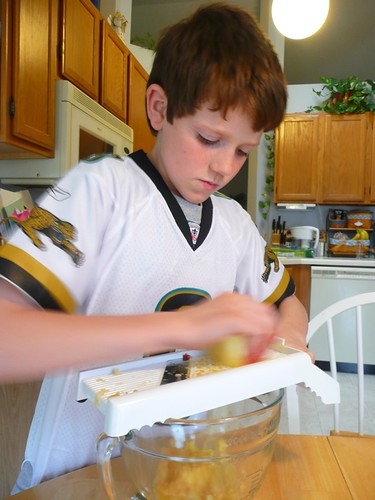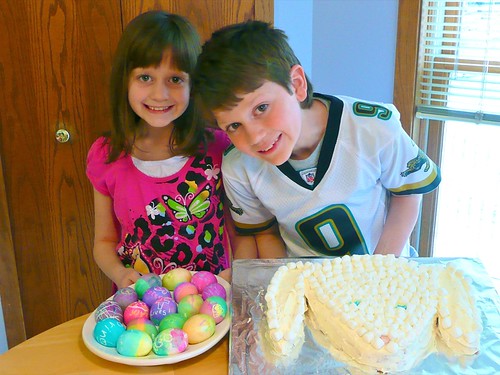
Over recent years I have heard of a number of families and churches observing Holy Week through the tradition of the Jewish Passover meal, or seder (SAY-der). This is the observance that commemorates God's faithfulness to Israel by providing protection and rescue from slavery in Egypt. It is an extremely powerful experience in that it appeals to all of our senses to help people of all ages grasp God's redemptive work on behalf of His people throughout history.
I researched the concept, and boiled down the wealth of information to some key elements that made it manageable for our family. The scripts we have used are found at these links:
Original script (2010)
Revised script (2012) (Preserves the content, but sets aside some of the structure to make a smoother flowing experience)
Jesus was observing the traditional Passover meal with his disciples in what we now call the Last Supper (Luke 22:7-30--the event we observe in Holy Week as "Maundy Thursday"). The transition from Old Covenant to New took place at the very time Jesus shared this meal with his disciples. No truths are more central to our faith than those demonstrated here.
One thing that intrigued me in my research was that each family or group geared the experience to the participants, and especially accommodated the ages and abilities (i.e. attention spans!) of the children. The script that I arrived at was somewhat challenging for my 8 and 10 year old, but it leaves room for increased understanding in the years ahead. They still thoroughly enjoyed it. They were excited about the idea from the beginning, and even more so when I involved them in the preparations. During the meal portion of the observance, where there is a break in the script for eating and talking together, we discussed what we had experienced so far, and the kids were digging back through the script to remember the details.
An internet search for “family passover meal” or “family seder meal” produced numerous results. I used the two below as resources for no particular reason other than the fact that they gave a lot of background (far beyond what I’ve included here) and complemented one another well in terms of offering very different possibilities that were at the same time consistent in upholding the tradition.
Now, a couple of years later, many more results are listed. It is well worth reading through several versions to glean the wealth of background and meaning inherent in the traditional meal observance. I especially enjoyed this script as I did a little further research to revise my own:
http://www.hillcrestcov.org/wp-content/uploads/2010/02/Script-and-Supplies-for-Hillcrest-Seder-Dinner.pdf
As a student of many of Beth Moore’s Bible studies, I am always captivated by her teaching on the Jewish feasts and traditions. She does a beautiful job of making the connections from the origins of the Old Testament practice to the fulfillment or illumination of it under the new covenant through Christ. In her study entitled Jesus the One and Only, she lays out the meanings behind the four cups in the Passover observance. I had never forgotten it from the time that I studied it probably eight or nine years ago. The most amazing part is that after the supper when Jesus took the cup, it was the third cup of the Passover meal, the cup known so well to the disciples as the cup of redemption. In the Old Testament promise associated with the third cup, God said to Israel, “I will redeem you with an outstretched arm.” (Exodus 6:6) At the very moment when Jesus took that third cup, he ushered in the new covenant saying, “This cup is the new covenant in my blood.” (Luke 22:20) Later he prayed in the garden, “Father, if you are willing, take this cup from me.” (Luke 22:42) Beth Moore associates this with that cup of redemption, which was so costly for Christ to bear. And then on the cross, indeed, Christ redeemed all of mankind with his outstretched arms.

I kept our meal as simple as possible so that the joy would not be lost in the work. We dyed our Easter eggs a day or two ahead of time. Boiled eggs are a traditional part of the Passover meal, and help brighten the table. It is a festive celebration, and meant to be beautiful. Bethany made the lamb cake the night before from an angel food mix. She even remarked as she poured it out of the package how white it was. I reminded her of that while we ate, because the script had already referenced Jesus as the spotless lamb without blemish or defect. To make the lamb shape, we used a round cake pan and a loaf pan. We then trimmed the circle for the face, and made ears from the loaf, frosted and decorated with marshmallows. I served raspberries with it.

The afternoon of the meal I bought a rotisserie chicken already prepared at the grocery store, and put it in a covered dish in the oven on low. I arranged all the greens on a plate, with a small bowl of salt water in the middle, and put the flatbread (also store bought) in a basket. I had the kids help me make the haroset. (Another recipe here.) After setting the table, I made stuffing, mashed potatoes and gravy from mixes and put them in the oven to stay warm. I had plenty of greens on the plate to use as salad, so it was very quick and easy to get the meal on the table.

No project has ever touched my heart more deeply than putting this observance together for our family. The evidence throughout scripture of God's plans to continually show us his love and faithfulness takes my breath away. The experience of the meal had a beautiful impact on our family, and the very effort itself was a blessing to me. It is my hope and prayer that others will be encouraged to participate in a meal like this, and experience God's presence in a profound way.

4 comments:
So this is what the home stretch looks like a few days before Passover. To be honest, I never paid as much attention to it before; meaning that it has never had the same feel, like time is running out and I gotta do something spectacular to make this the most fantastic year ever. There’s never enough time to really get it right, so I suppose if we asked HaShem to postpone things a little we would only have to search deeper within our souls to cleanse ourselves of arrogance. Thus, we have to make do with the precious little time we’ve got left and cram a whole year’s worth of soul searching in the next fourteen days. It’s like having the last time up at bat, bottom of the ninth inning, trailing by one, two outs, bases are loaded and we’ve got one last chance to hit that sucker out of the park for a grand-slam ending in an underdog winner-take-all scenario. Read more at http://moshesharon.wordpress.com
Interesting comment, MS! I read the linked article, and see that you are clearly Jewish. I would love to know what you think about the script I am referencing here, and whether it speaks of the Jewish observance of the Passover meal with integrity. What I noticed in your article (included in the excerpt above) is the pressure we feel to make the most of a certain observance at a certain time in the year--whether the rest our life appears to have room for it in this particular year or not. I am charmed by the baseball analogy, for Easter and Passover are late this year, and it really is already baseball time which translates into BUSY time for us. The Easter celebration is NOT a homerun for us every year! I think God can handle that.
What a wonderful tradition! When I was a kid, we lived next door to a Jewish family. We shared Seder with them and they shared Easter with us. Did the same thing during the Hannukah/Christmas season. BTW, latkes are now one of my favorite foods...
I hope to do a seder this year. I want to so badly. I've learned so much over the last year about our Jewish roots and I'm convinced we need to take part in these observances. I've learned a lot from Beth Moore as well in this area.
I think you e-mailed me the script last year. I'm going to go back in my file and look.
I'm glad you posted this again.
Right now I'm reading Our Father Abraham, Jewish Roots of the Christian Faith and just finished Yeshua - A guide to the Real Jesus and the Original Church. Both are great books to learn from.
Next Year in Jerusalem. Cheers.
♥ Joy
Post a Comment